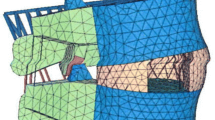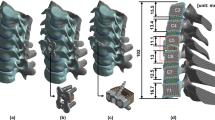Abstract
The purpose of this study was to evaluate the biomechanical effect of a hat type cervical intervertebral fusion cage (HCIFC). In this in vitro biomechanical study, 48 goat cervical spines (C2-5) were tested in flexion, extension, axial rotation, and lateral bending with a nondestructive stiffness method using a nonconstrained testing apparatus, and three-dimensional displacement was measured. Autologous iliac bone and cervical spine intervertebral fusion cage were implanted according to manufacturers’ information after complete discectomy (C3-4). Eight spines in each of the following groups were tested: intact, autologous iliac bone graft, Harms cage, SynCage C, carbon cage, and HCIFC. The mean apparent stiffness values were calculated from the corresponding load-displacement curves. Additionally, cage volume and volume-related stiffness were determined. The stiffness of the SynCage C was statistically greatest in all directions. After implantation of the HCIFC, flexion stiffness increased compared with that of the intact motion segment. There was no significant difference in stiffness between the HCIFC and carbon cage. The stiffness of the HCIFC was statistically higher than that of the Harms cage in axial rotation and significantly lower in flexion, extension, and lateral bending. Volume-related stiffness of all cages was higher than that of iliac bone graft. The Harms cage was highest in volume-related stiffness in all directions. The HCIFC can provide enough primary stability for cervical intervertebral fusion.
Résumé
Le but de cette étude est d’évaluer les effets biomécaniques de HCIFC. Méthode: une étude biomécanique a été conduite sur 48 colonnes cervicales de chèvres de C2 à C5, testées en flexion extension, rotation axiale, bending avec mesure des déplacements tridimensionnels. Une greffe d’os iliaque, une cage intervétébrale ont été implantés pour discectomie (C3-C4). 8 colonnes dans chaque groupe ont été testées. Résultats: la résistance de la Syncage C est statistiquement plus importante dans toutes les directions après l’implantation de la HCIFC raideur en flexion, la résistance en flexion est augmentée si on la compare à un segment atteint. Il n’y a pas de différence dans la résistance entre la HCIFC et la cage en carbone. La résistance de la HCIFC est statistiquement plus importante que la Harms cage en rotation axiale et significativement moins importante en flexion, extension et en bending latéral. La résistance est plus importante avec toutes les cages si on la compare à une greffe iliaque. La Harms cage semble donner le meilleur résultat dans toutes les directions. En conclusion: la HCIFC semble donner une bonne stabilité primaire pour une fusion inter cervical vertébral.


Similar content being viewed by others
References
Brooke NS, Rorke AW, King AT et al (1997) Preliminary experience of carbon fibre cage prostheses for treatment of cervical spine disorders. Br J Neurosurg 11:221–227
Kumaresan S, Yoganandan N, Pintar FA (1997) Finite element analysis of anterior cervical spine interbody fusion. Biomed Mater Eng 7:221–230
Majd ME, Vadhva M, Holt RT (1999) Anterior cervical reconstruction using titanium cages with anterior plating. Spine 24:1604–1610
Matge G (1998) Anterior interbody fusion with the BAK-cage in cervical spondylosis. Acta Neurochir 140:1–8
Munoz FLO, de las Heras BG, Lopez VC et al (1998) Comparison of three techniques of anterior fusion in single-level cervical disc herniation. Eur Spine J 7:512–516
Kandziora F, Schollmeier G, Scholz M et al (2002) Influence of cage design on interbody fusion in a sheep cervical spine model. J Neurosurg 96(3 Suppl):321–332
Matge G (2002) Cervical cage fusion with 5 different implants: 250 cases. Acta Neurochir (Wien) 144:539–549, discussion 50
Weiner BK, Fraser RD (1998) Spine update lumbar interbody fusion cages. Spine 23:634–640
Kandziora F, Pflugmacher R, Scholz M et al (2001) Comparison between sheep and human cervical spines: an anatomic, radiographic, bone mineral density, and biomechanical study. Spine 26:1028–1037
Goh JC, Wong HK, Thambyah A et al (2000) Influence of PLIF cage size on lumbar spine stability. Spine 25:35–39
Kim KW, Ha KY, Moon MS et al (1999) Volumetric change of the graft bone after intertransverse fusion. Spine 24:428–433
Wilke HJ, Kettler A, Claes LE (1997) Are sheep spines a valid biomechanical model for human spines? Spine 22:2365–2374
Cain CC, Fraser RD (1995) Bony and vascular anatomy of the normal cervical spine in the sheep. Spine 20:759–765
Pait GT, Killefer JA, Arnautovic KI (1996) Surgical anatomy of the anterior cervical spine: the disc space, vertebral artery, and associated bony structures. Neurosurgery 39:769–776
Jost B, Cripton PA, Lund T et al (1998) Compressive strength of interbody cages in the lumbar spine: the effect of cage shape, posterior instrumentation, and bone density. Eur Spine J 7:132–141
Wilke HJ, Kettler A, Goetz C et al (2000) Subsidence resulting from simulated postoperative neck movements: an in vitro investigation with a new cervical fusion cage. Spine 25(21):2762–2770
Kanayama M, Cunningham BW, Haggerty CJ et al (2000) In vitro biomechanical investigation of the stability and stress-shielding effect of lumbar interbody fusion devices. J Neurosurg (2 Suppl) 93:259–265
Author information
Authors and Affiliations
Corresponding author
Additional information
An erratum to this article can be found at http://dx.doi.org/10.1007/s00264-006-0264-y
Rights and permissions
About this article
Cite this article
Gu, YT., Jia, LS. & Chen, TY. Biomechanical study of a hat type cervical intervertebral fusion cage. International Orthopaedics (SICO 31, 101–105 (2007). https://doi.org/10.1007/s00264-006-0141-8
Received:
Revised:
Accepted:
Published:
Issue Date:
DOI: https://doi.org/10.1007/s00264-006-0141-8




